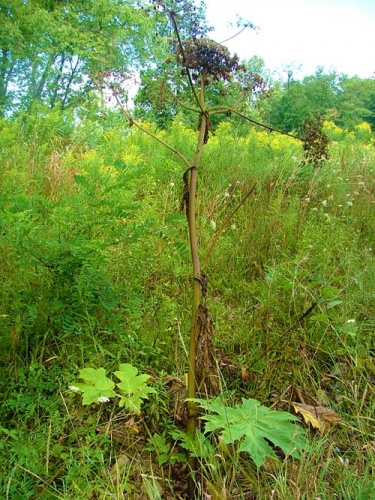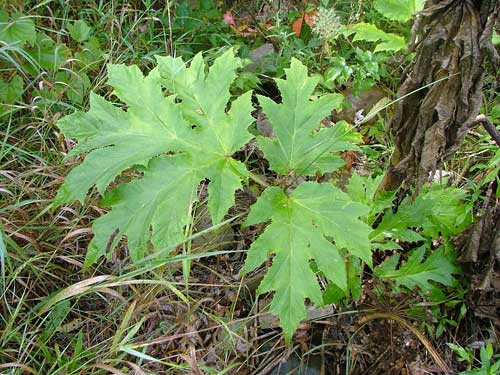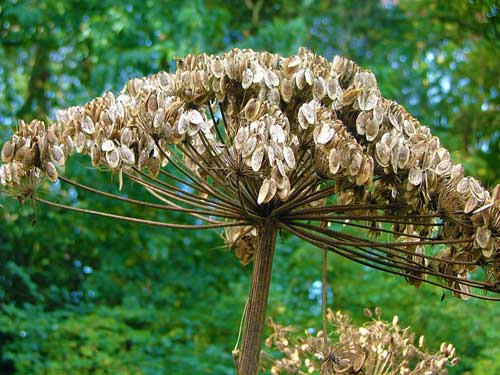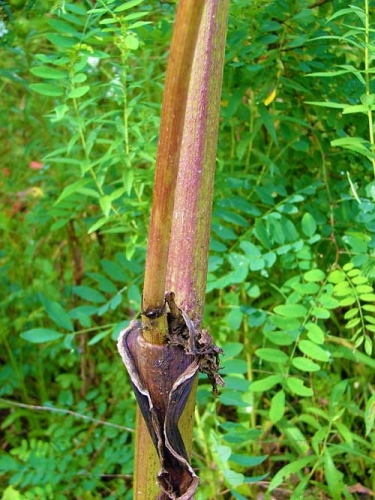Giant hogweed in the landscape
Recent press reports have brought attention to giant hogweed. With a good, digital photo, you can get confirmation whether or not your plant is hogweed and then follow the advised safety precautions for removal.
Giant hogweed may look like a beautiful architectural addition to the landscape, but this dramatic perennial plant also has a sinister side. As its Latin name implies, Heracleum mantegazzianum looks a little like Hercules when it reaches its full height of 6 to 12 feet in Michigan. It can cause a painful skin reaction, including burning blisters, red blotches and purple or black scars. Residents who think they have spotted the deadly beauty can e-mail photographs of the plant, leaves, flower head and stem where the leaf joins the stem to Michigan State University Diagnostic Services at pestid@msu.edu for identification.
Those who discover the plant are encouraged not to touch or try to remove it without proper protection. The U.S. Department of Agriculture recommends never touching the plant with your bare hands. Always handle with non-permeable gloves and full covering with clothes that can be laundered with detergent or bagged and thrown away. Remember that the sap can persist on mowers, string trimmers, tools and gloves afterward.
Identifying giant hogweed
With a chunky, greenish-purple stem and platter-sized, deeply dissected foliage, giant hogweed was introduced from Eurasia by plant collectors in the early 1900s for arboretums and gardens. Abundant seeds are produced from frothy, white blooms similar to Queen Anne’s lace and are held on strong stalks, well above the foliage. Its persistent biology coupled with prolific seed production allowed this villain to quickly escape and establish itself in moist soils along roadsides and stream banks. It easily moved towards Michigan from the East Coast through Pennsylvania.


Early summer’s growth shows large, dissected leaves at the base of old flower stalks.

Hollow stems show a tinge of purple and are coarse.
The sinister side of giant hogweed is unveiled when unknowing gardeners or landscape managers come into contact with the seed, foliage and stems, exposing themselves to the dangerous sap. Classified along with the lowly carrot, this family also includes Queen Anne’s lace and parsley, but it contains toxins that can cause severe skin and eye irritation. If you ever have experienced the effects of poison ivy, this is a hundred times worse. Skin contact when exposed to sunlight “activates” the dermatitis reaction, causing it to create painful blisters. Contact with eyes can cause temporary or even permanent blindness, and skin contact may leave long-lasting scars.

Last year’s seed heads are gently rounded on top and flat on the bottom.
Hazardous plant
Giant hogweed made it to the USDA dangerous noxious weed list and has been scouted for in Michigan since 1998. Small seedlings can be controlled with a labeled herbicide containing glyphosate, but most references state that a mature giant hogweed plant will not succumb to a single application. Controlling with a herbicide will require tenacious attention, reapplication to basal sprouts and a keen eye for germinating seedlings as seedlings can germinate for several seasons.
Look-a-likes
Giant hogweed has certainly been confused with some of its benign relatives including our native Angelica and cow parsnip. Both of these plants are stately and dramatic looking, but not nearly so large as giant hogweed. For more information on giant hogweed, see MSU Extension Bulletin E-2935A "Giant Hogweed: An attractive but dangerous federal noxious weed. Have you seen this plant in Michigan?" You can also visit michigan.gov/exoticpests and scroll to the bottom to get a glimpse of giant hogweed.
Find out about other educational resources and classes at www.migarden.msu.edu and at Finneran’s blog. You can contact the MSU Master Gardener Lawn and Garden Hotline at 888-678-3464 with your questions.



 Print
Print Email
Email

